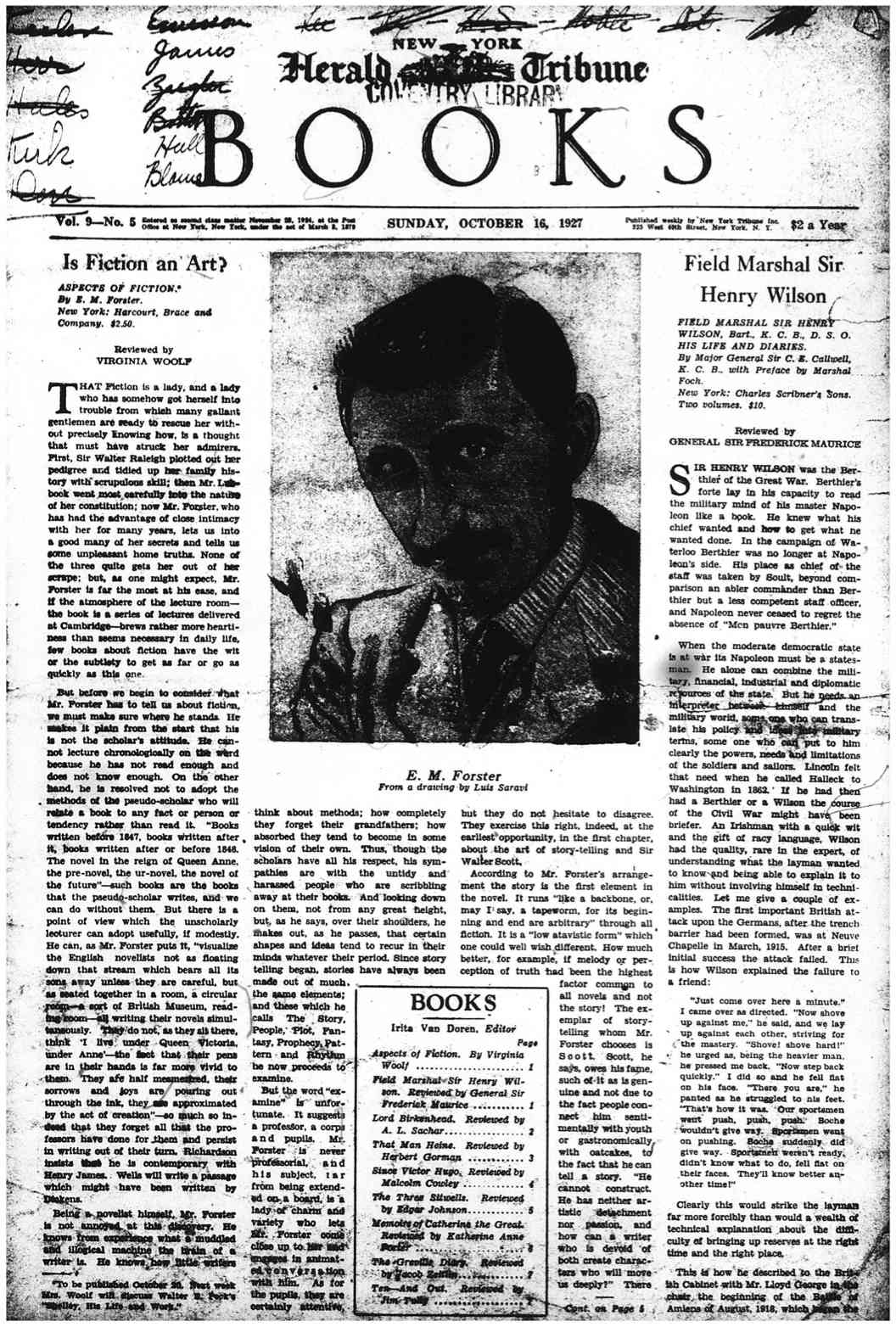
Is Fiction an Art?
ASPECTS OF FICTION.
By E. M. Forster
New York: Harcourt, Brace and
Company. $2.50
Reviewed by
VIRGINIA WOOLF
THAT fiction is a lady, and a lady
who has somehow got herself into
trouble from which many gallant
gentlemen are ready to rescue her with-
out precisely knowing how, is a thought
that must have struck her admirers.
First, Sir Walter Raleigh plotted out her
pedigree and tidied up her family his-
tory with scrupulous skill; then Mr. Lub-
bock went most carefully into the nature
of her constitution; now Mr. Forster, who
has had the advantage of close intimacy
with her for many years, lets us into
a good many of her secrets and tells us
some unpleasant home truths. None of
the three quite gets her out of her
scrape; but, as one might expect, Mr.
Forster is far the most at his ease, and
if the atmosphere of the lecture roomŌĆö
the book is a series of lectures delivered
at CambridgeŌĆöbrews rather more hearti-
ness than seems necessary in daily life,
few books about fiction have the wit
or the subtlety to get as far or go as
quickly as this one.
But before we begin to consider what
Mr. Forster has to tell us about fiction,
we must make sure where he stands. He
makes it plain from the start that his
is not the scholarŌĆÖs attitude. He can-
not lecture chronologically on the word
because he has not read enough and
does not know enough. On the other
hand, he is resolved not to adopt the
methods of the pseudo-scholar who will
relate a book to any fact or person or
tendency rather than read it. ŌĆ£Books
written before 1847, books written after
it, books written after or before 1848.
The novel in the reign of Queen Anne,
the pre-novel, the ur-novel, the novel of
the futureŌĆØŌĆösuch books are the books
that the pseudo-scholar writes, and we
can do without them. But there is a
point of view which the unscholarly
lecturer can adopt usefully, if modestly.
He can, as Mr. Forster puts it, ŌĆ£visualize
the English novelists not as floating
down that stream which bears all its
sons away unless they are careful, but
as seated together in a room, a circular
roomŌĆöa sort of British Museum, read-
ing roomŌĆöall writing their novels simul-
taneously. They do not, as they sit there,
think ŌĆśI live under Queen Victoria,
under AnneŌĆÖŌĆöthe fact that their pens
are in their hands is far more vivid to
them. They are half mesmerized, their
sorrows and joys are pouring out
through the ink, they are approximated
by the act of creationŌĆØŌĆöso much so in-
deed that they forget all that the pro-
fessors have done for them and persist
in writing out of their turn. Richardson
insists that he is contemporary with
Henry James. Wells will write a passage
which might have been written by
Dickens.
Being a novelist himself, Mr. Forster
is not annoyed at this discovery. He
knows from experience what a muddled
and illogical machine the brain of a
writer is. He knows how little writers
____
*To be published October 20. Next week
Mrs. Woolf will discuss Walter E. PeckŌĆÖs
ŌĆ£Shelley, His Life and Work.ŌĆØ
[new column]
think about methods; how completely
they forget their grandfathers; how
absorbed they tend to become in some
vision of their own. Thus, though the
scholars have all his respect, his sym-
pathies are with the untidy and
harassed people who are scribbling
away at their books. And looking down
on them, not from any great height,
but, as he says, over their shoulders, he
makes out, as he passes, that certain
shapes and ideas tend to recur in their
minds whatever their period. Since story
telling began, stories have always been
made out of much
the same elements;
and these which he
calls The Story,
People, Plot, Fan-
tasy, Prophecy, Pat-
tern and Rhythm
he now proceeds to
examine.
But the word ŌĆ£ex-
amineŌĆØ is unfor-
tunate. It suggests
a professor, a corps
and pupils. Mr.
Forster is never
professorial, and
his subject, far
from being extend-
ed on a board, is a
lady of charm and
variety who lets
Mr. Forster come
close up to her and
engages in animat-
ed conversation
with him. As for
the pupils, they are
certainly attentive,
[new column]
but they do not hesitate to disagree.
They exercise this right, indeed, at the
earliest opportunity, in the first chapter,
about the art of story-telling and Sir
Walter Scott.
According to Mr. ForsterŌĆÖs arrange-
ment the story is the first element in
the novel. It runs ŌĆ£like a backbone, or,
may I say, a tapeworm, for its begin-
ning and end are arbitraryŌĆØ through all
fiction. It is a ŌĆ£low atavistic formŌĆØ which
one could well wish different. How much
better, for example, if melody or per-
ception of truth had been the highest
factor common to
all novels and not
the story! The ex-
emplar of story-
telling whom Mr.
Forster chooses is
Scott. Scott, he
says, owes his fame,
such of it as is gen-
uine and not due to
the fact people con-
nect him senti-
mentally with youth
or gastronomically
with oatcakes, to
the fact that he can
tell a story. ŌĆ£He
cannot construct.
He has neither ar-
tistic detachment
nor passion, and
how can a writer
who is devoid of
both create charac-
ters who will move
us deeply?ŌĆØ There
___
Cont. on Page 5






